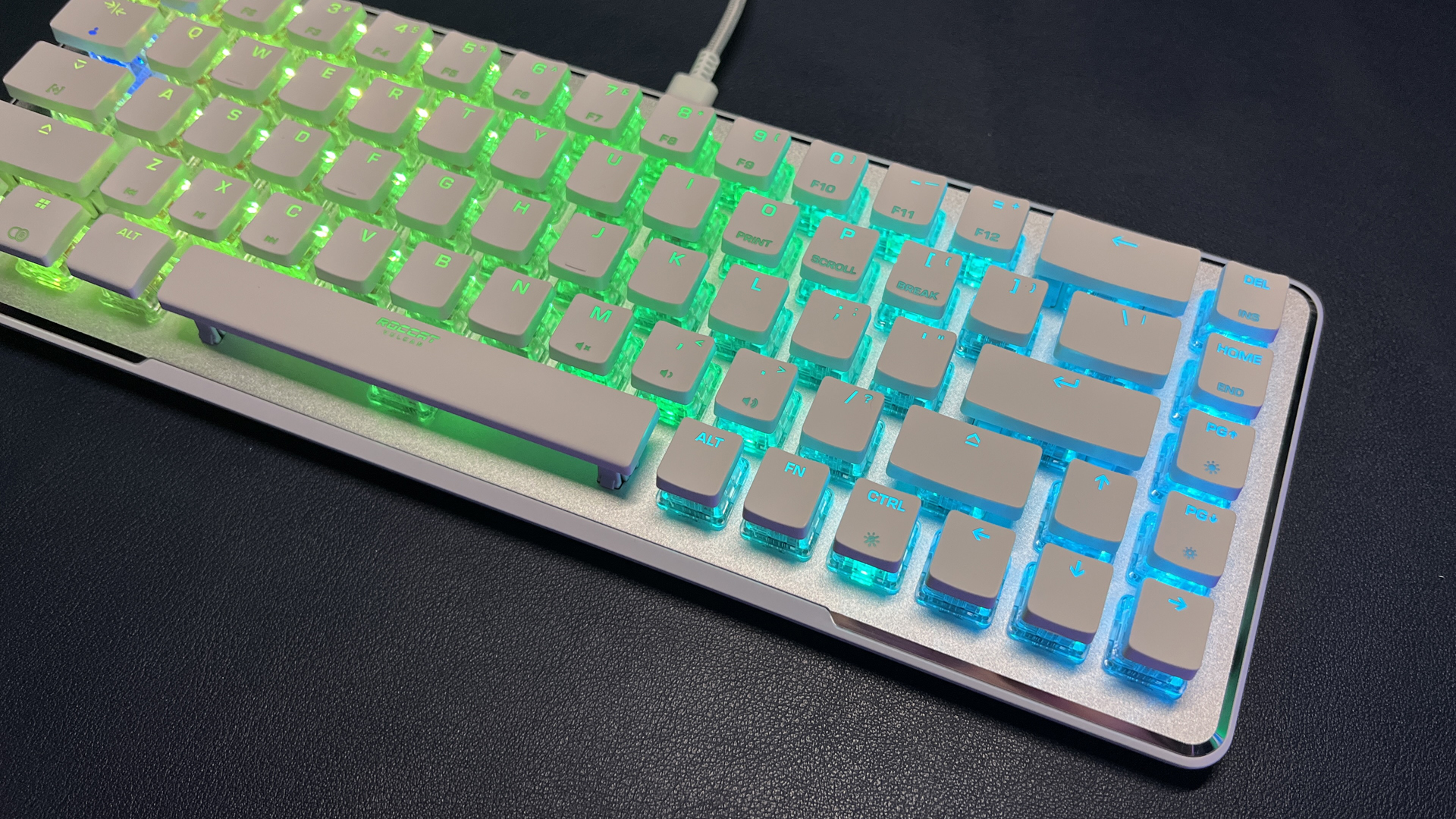Tom's Hardware Verdict
Roccat’s Vulcan II Mini is a 65 percent keyboard with bright, colorful, and admittedly ostentatious lighting, but at least it doesn’t look like every other ultra-compact keyboard on the market. Oh, and don’t get me started on the software.
Pros
- +
Speedy optical switches
- +
Pretty lights
- +
Better-than-expected typing experience
Cons
- -
Keyboard programmability is ridiculously convoluted
- -
Slippery keycaps
Why you can trust Tom's Hardware
Deskspace comes at a premium these days — at least, that’s what you might think with the way gaming companies are dropping mini keyboards left and right. Gamers looking for the best gaming keyboard aren’t usually considering ultra-compact 60 or 65 percent form factors, but maybe they should be as companies are packing these mini-boards with features.
Roccat’s new Vulcan II Mini is a 65 percent wired keyboard with bright, eye-catching per-key RGB, which it shows off with unique Dual-LED smart switches and Roccat’s attractive “organic” Aimo lighting experience. The Vulcan II Mini features the company’s Titan II optical red (linear) switches which have n-key rollover (NKRO) with 100% anti-ghosting, as well as an anodized aluminum top plate. The keyboard comes in both black and white (we requested our review model in white — just to mix it up), and is available now for $150.
Design and Construction of the Vulcan II Mini

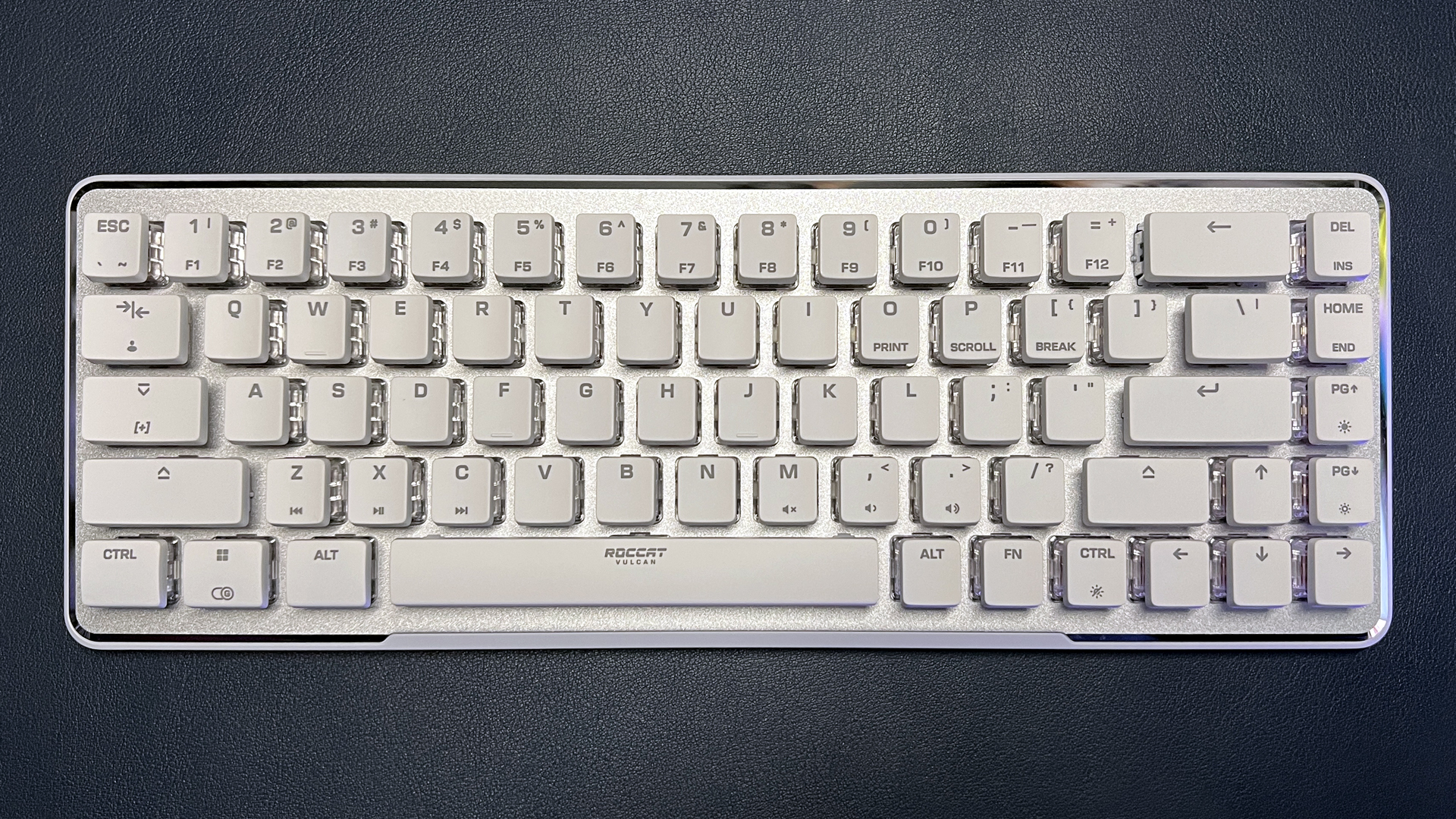
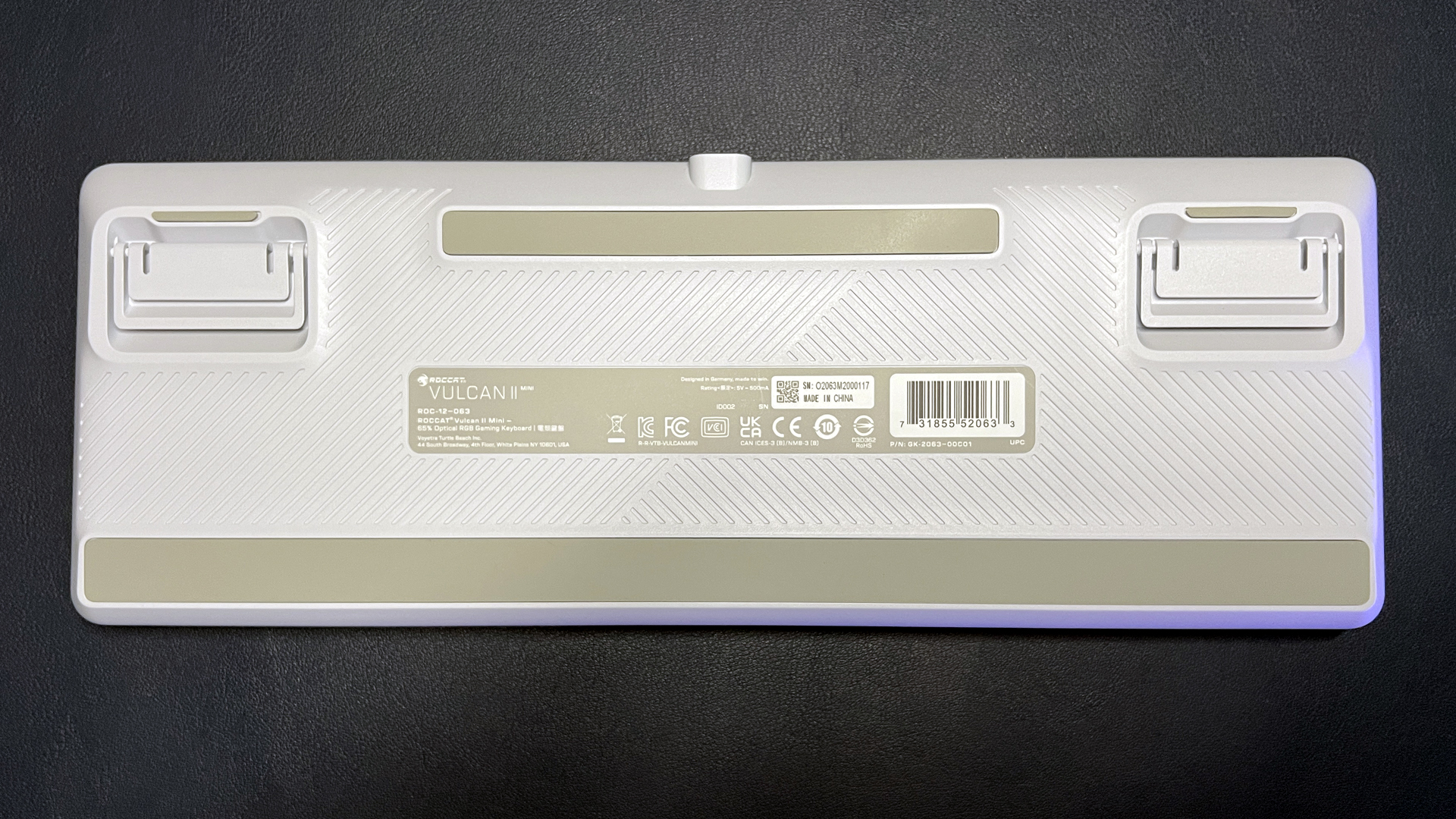

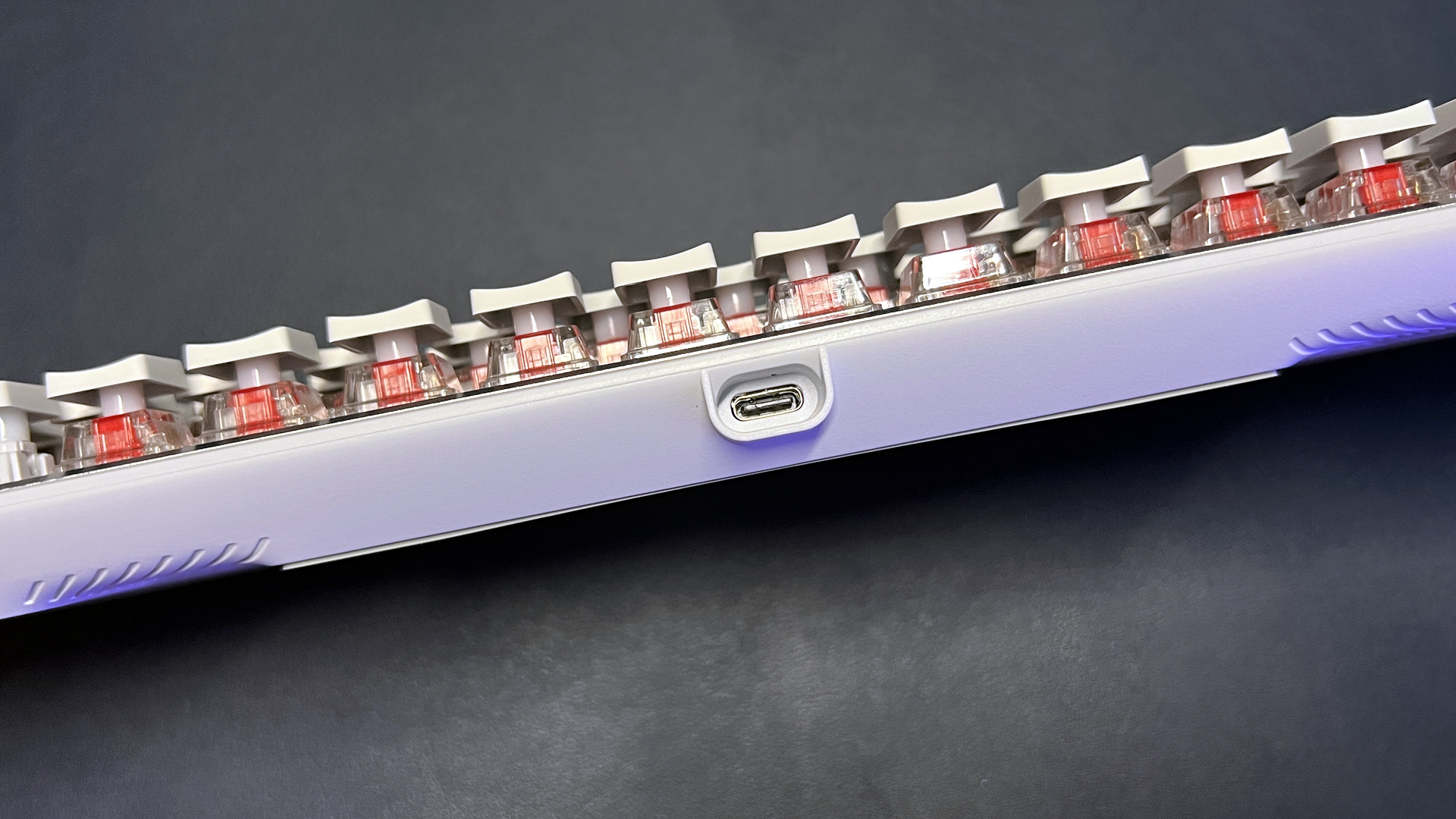
The Vulcan II Mini is a 65 percent keyboard — it’s ultra-compact, but it’s not ultra-compact. Unlike a keyboard with a 60 percent layout, such as the SteelSeries Apex Pro Mini or the Corsair K70 Pro Mini Wireless, the Vulcan II Mini’s layout retains arrow keys and a handful of navigation keys (delete, home, page up, and page down). This makes it slightly longer than a 60 percent board, but at 12.75 inches long by 4.57 inches deep, the Vulcan II Mini is still pretty tiny. It’s also slimmer than both of the aforementioned 60 percent boards (1.22 inches thick vs the Apex Pro Mini/K70 Pro Mini Wireless’ 1.59 inches) and lighter (1.1lbs vs the Apex Pro Mini’s 1.2lbs and the K70 Pro Mini Wireless’ 1.42lbs), so it feels pretty lightweight overall.
The Vulcan II Mini is housed in a lightweight plastic chassis topped with an anodized aluminum backplate. The underside of the chassis features dual flip-out feet for angle adjustment, as well as long rubber strips for grip — allowing the keyboard to stay put (despite its relatively light weight) through aggressive bouts of typing and gaming.
The Vulcan II Mini comes in both black and white colorways; I requested a review model in white because all of the black mini keyboards are starting to blend together at this point. However, I don’t think even the black version of the Vulcan II Mini would look like recent competitor drops, as Roccat’s slim keycaps and exposed switches definitely make this keyboard stand out visually.
The keyboard features white ABS keycaps with translucent legends — including translucent secondary legends for the board’s 30 multi-function keys with preset secondary functions. Secondary functions are a must on an ultra-compact keyboard, but a couple of this keyboard’s secondary functions used symbols that weren’t immediately intuitive
According to Roccat, this keyboard features the world’s first Dual-LED smart switches, which is...basically what it sounds like: Two LEDs in one switch. Is it revolutionary? Not really. Does it work? Yes — each Dual-LED smart switch can display two different LED colors (north and south). This causes the primary legend (north) and secondary legend (south) to light up in different colors (or at different brightness levels), so you can quickly see which secondary functions are active.
Get Tom's Hardware's best news and in-depth reviews, straight to your inbox.
It’s not totally seamless, however: Because the Vulcan II Mini’s switches are exposed, the south-facing LEDs are very visible to the user. This isn’t an issue if those LEDs are turned off/down, but it does make for a somewhat jarring aesthetic if they’re set to a different color. This is a pretty minor overall concern, but it was jarring enough that I initially thought some of the keys were experiencing a hardware malfunction.
The keyboard’s per-key RGB is otherwise very attractive, assuming you are an RGB enthusiast. The RGB is bright and vibrant, and the keyboard’s exposed switches let you basically bathe in it. It ships with Roccat’s Aimo lighting profile, which is a “state-of-the-art intelligent lighting system” that allegedly reacts “organically” to your behavior as well as the apps and devices you use. I didn’t necessarily see it reacting to my behavior beyond animations that followed my keystrokes (which doesn’t seem particularly intelligent), but the colorful, non-uniform patterns were pretty regardless.
The Vulcan II Mini is a wired keyboard and has a USB-C port at its top-center. It comes with a six-foot braided USB-C to USB-A cable which has a couple of nice touches — an attached velcro cable tie, and its USB-A connector is labeled with a keyboard icon for easy cable identification.
Specifications
| Switches | Roccat Titan II Optical Red Linear Switches |
| Lighting | Per-key RGB |
| Onboard Storage | Yes, 5 profiles |
| Media Keys | No |
| Game Mode | Yes |
| Connectivity | Wired (USB-C, detachable) |
| Additional Ports | None |
| Keycaps | ABS |
| Construction | Plastic, Aluminum top plate |
| Software | Roccat Swarm |
| Dimensions (LxWxH) | 12.75 x 4.57 x 1.22 inches / 324 x 116 x 31mm |
| Weight | 1.1lbs / 500g (without cable) |
Typing Experience and Gaming Experience on the Vulcan II Mini
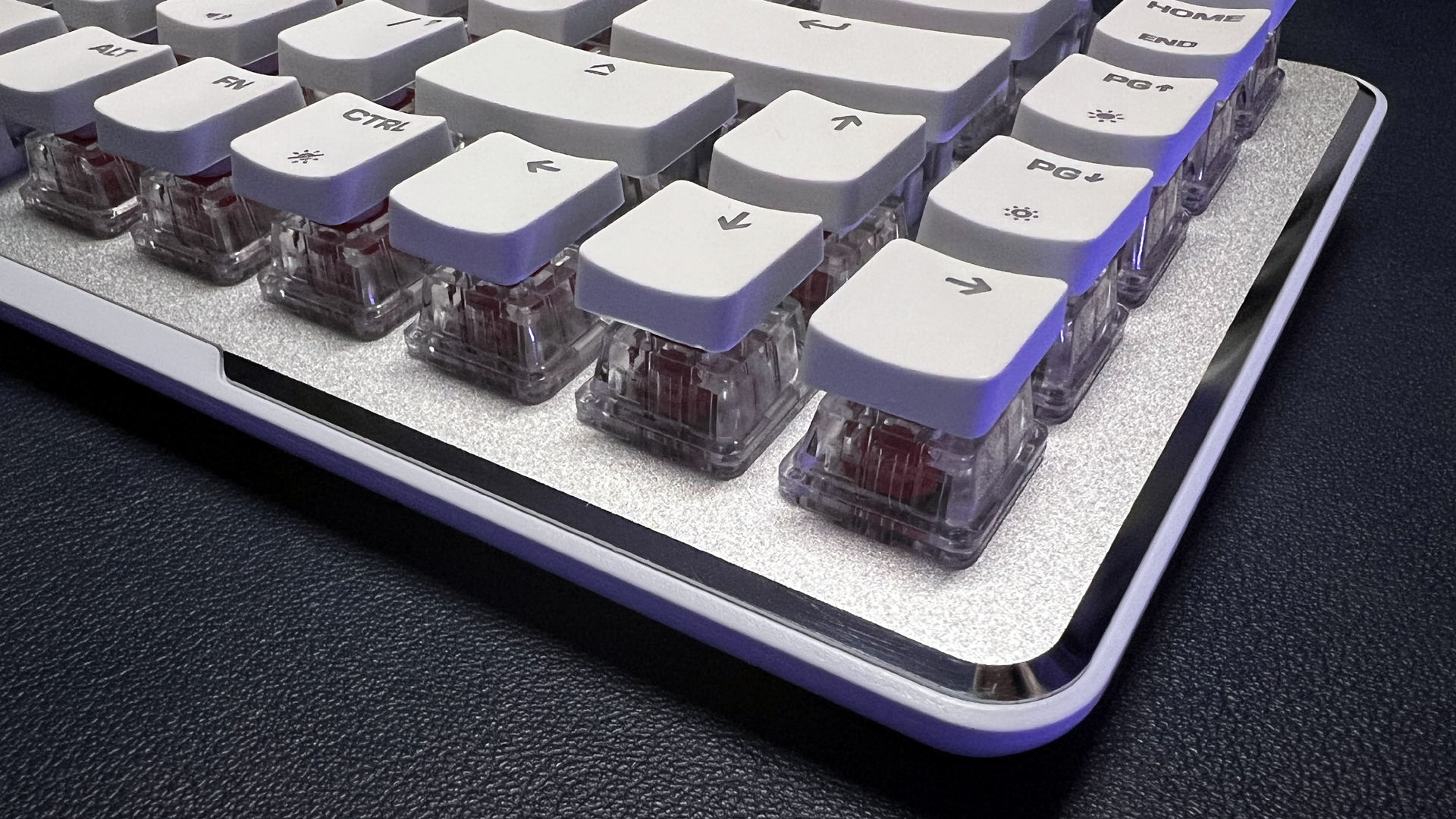
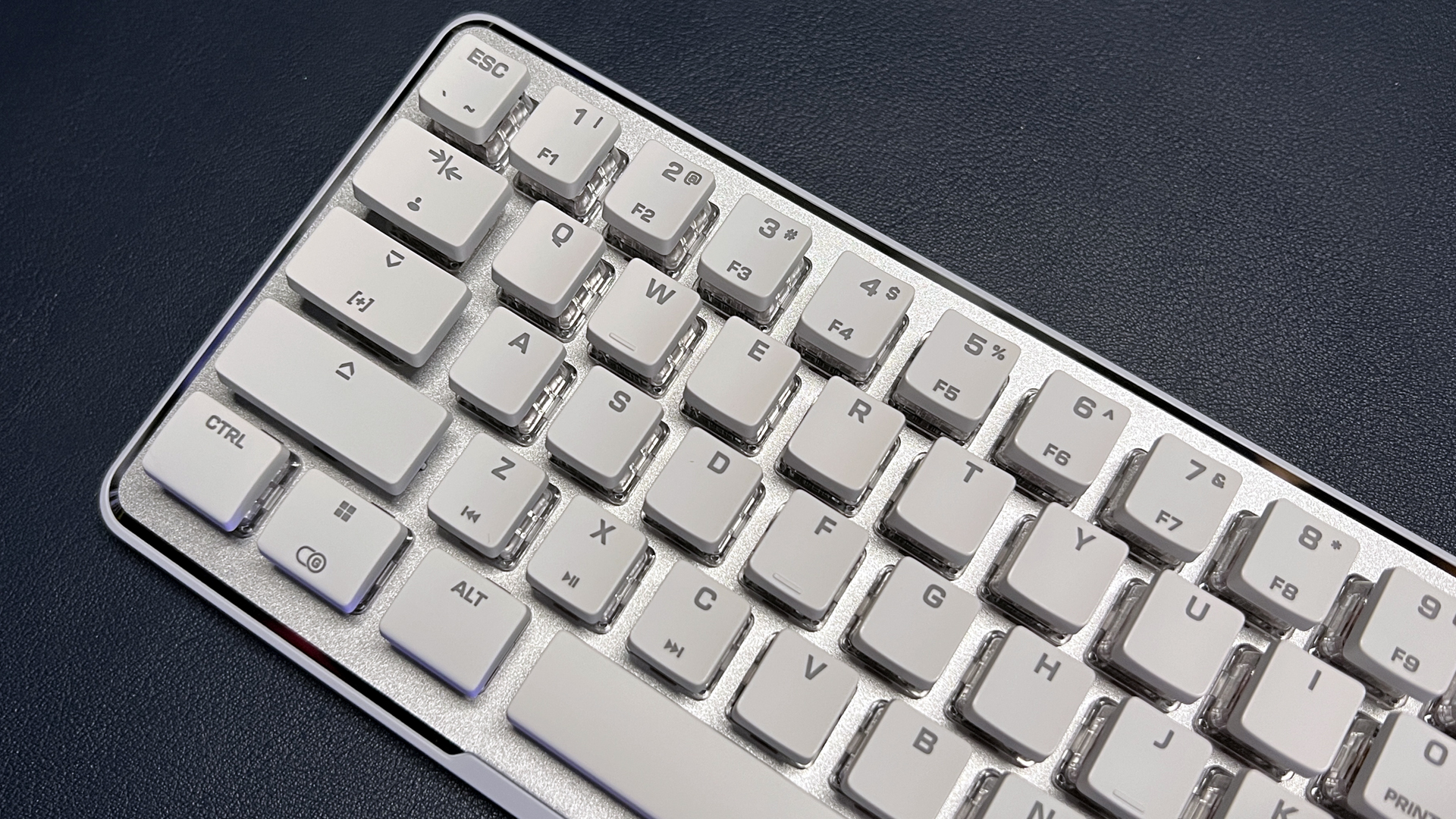
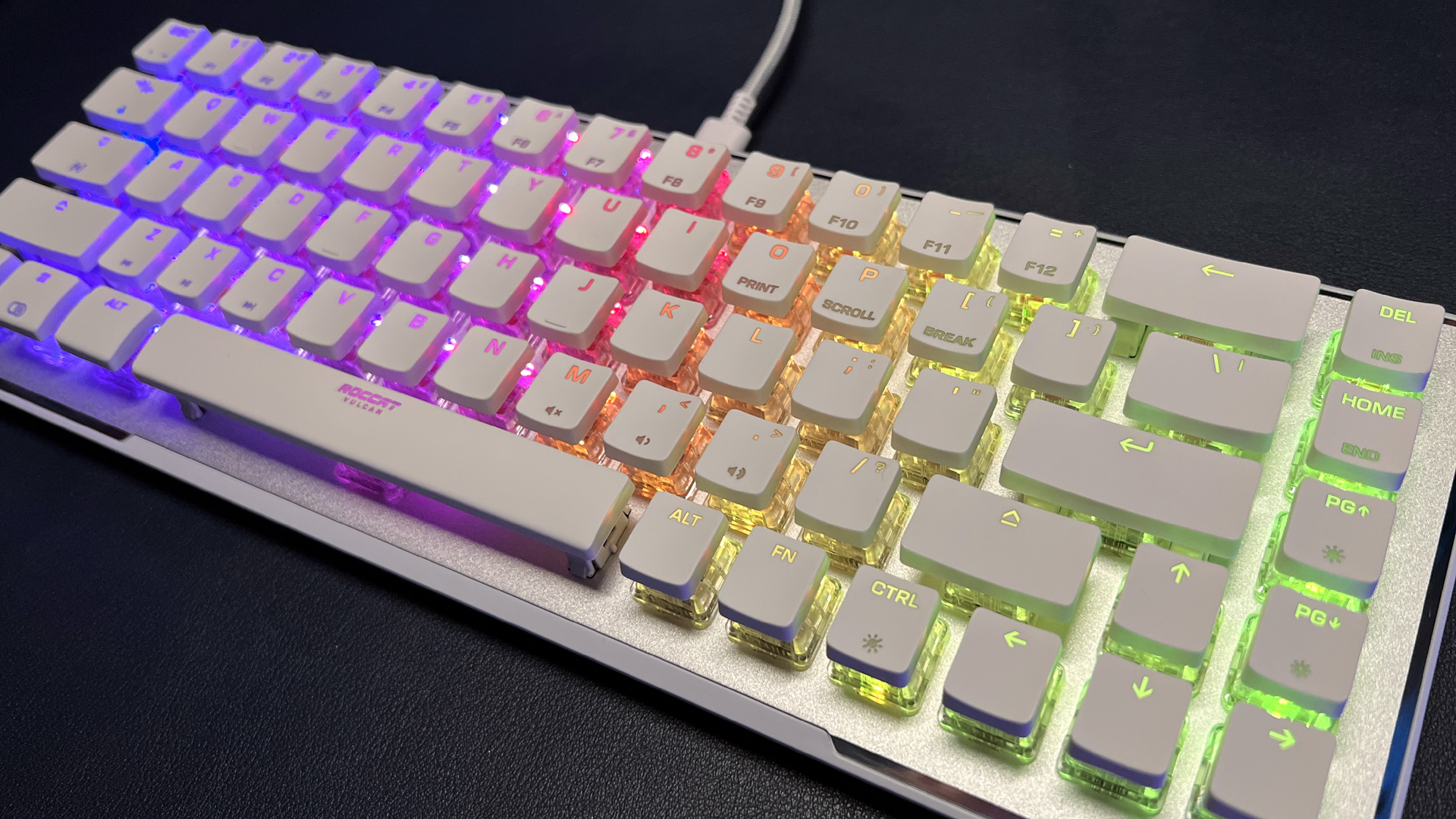
The Vulcan II Mini sports Roccat’s Titan II Optical Red linear switches; optical means they’re actuated by light (not force), while linear means there’s no click or tactile bump — just a smooth, uniform keypress. The switches are rated for 100 million keystrokes, and have an actuation point of 1.4mm and a travel distance of 3.6mm.
Typing on the Vulcan II Mini was a little better than expected, but this isn’t a keyboard I’d recommend for overall typing experience. The keyboard’s thin ABS keycaps are a little too lightweight and fluttery for the type of loud, decisive typing I’m prone to, and as a result my speed took a hit (104 wpm, down from 120 wpm — similar to my typing speed on the SteelSeries Apex Pro Mini). My accuracy remained pretty high, however (97.1%, which is typical for me), and I think it’s because the space between the keys — which is slightly larger than average — managed to prevent my fingers from hitting adjacent keys even as they slipped.
The Vulcan II Mini’s Titan II Optical Red linear switches are much better-suited to gaming. The linear lack of resistance and snappy optical responsiveness — even the speedy bounceback of the lightweight keycaps — allows you to make lightning-quick keypresses and fly around the keyboard without missing a stroke. Speed and (relative) accuracy are especially important on keyboards like the Vulcan II Mini if you play any games that require more than what the ultra-compact layout allows for — you need to be able to zip in and out of the first and second (and third) layers of functionality.
The only small complaint I had regarding gaming on the Vulcan II Mini is with its keycap material. The keycaps themselves are very lightly dished — enough to keep your fingers comfortable while typing — but caps’ ABS surface is pretty slick to begin with and only gets slicker as gaming ramps up. I actually sweat very little (in gaming, and also in general), and the Vulcan II Mini’s keycaps were frustratingly slippery during fast-paced action. If you sweat at all, this may not be the keyboard (or, well, these may not be the keycaps) for you.
Features and Software of the Vulcan II Mini
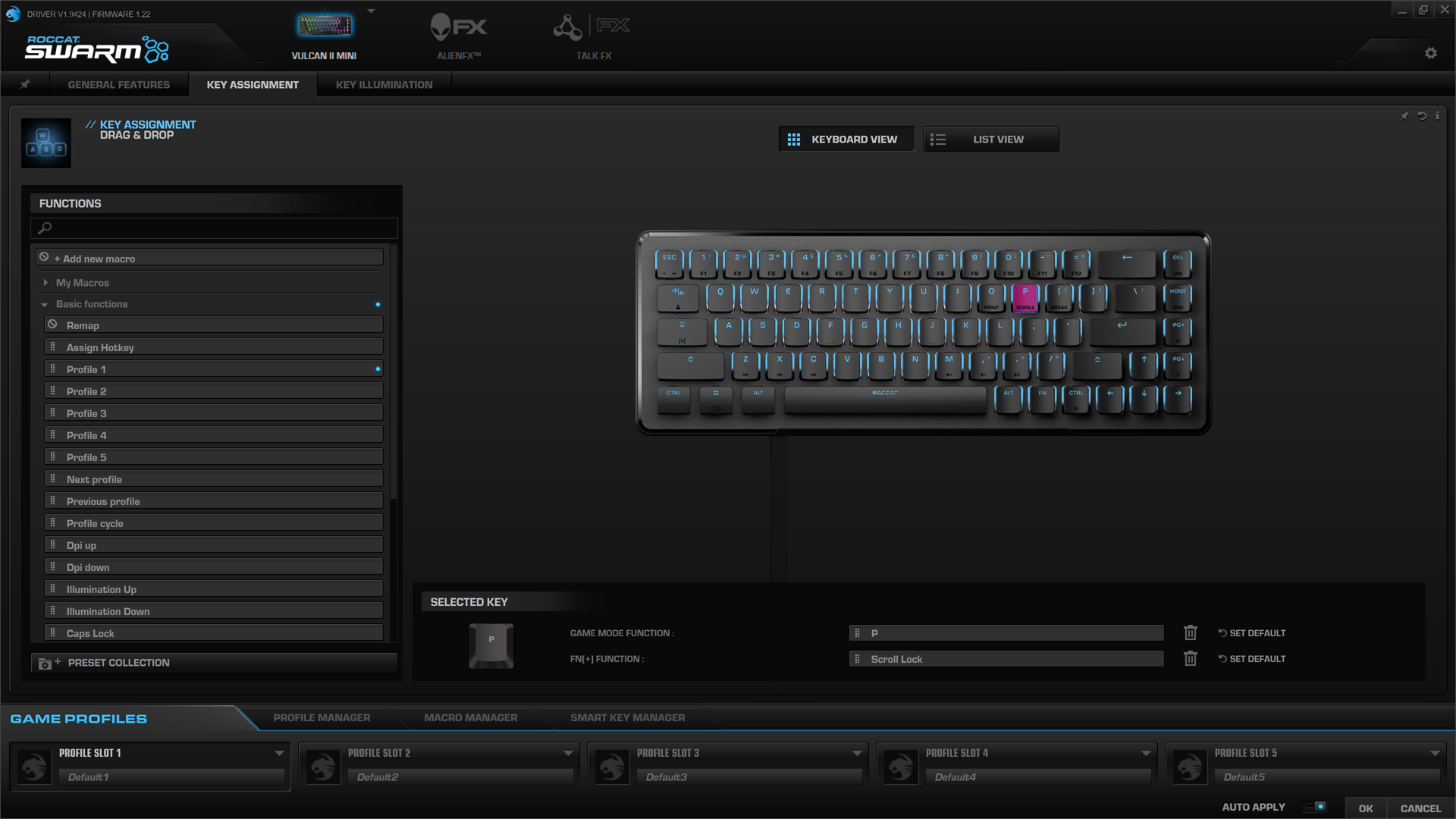
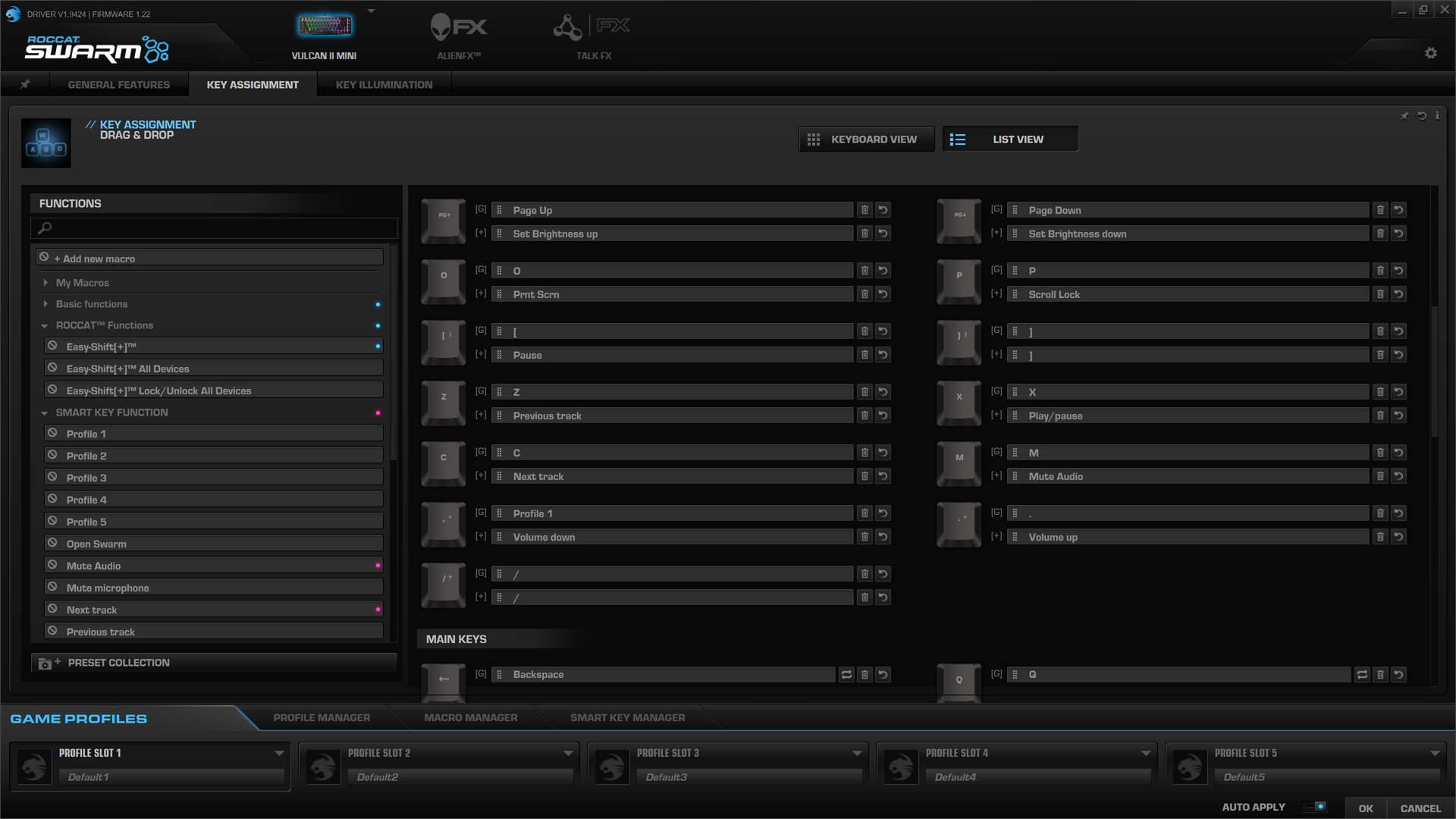
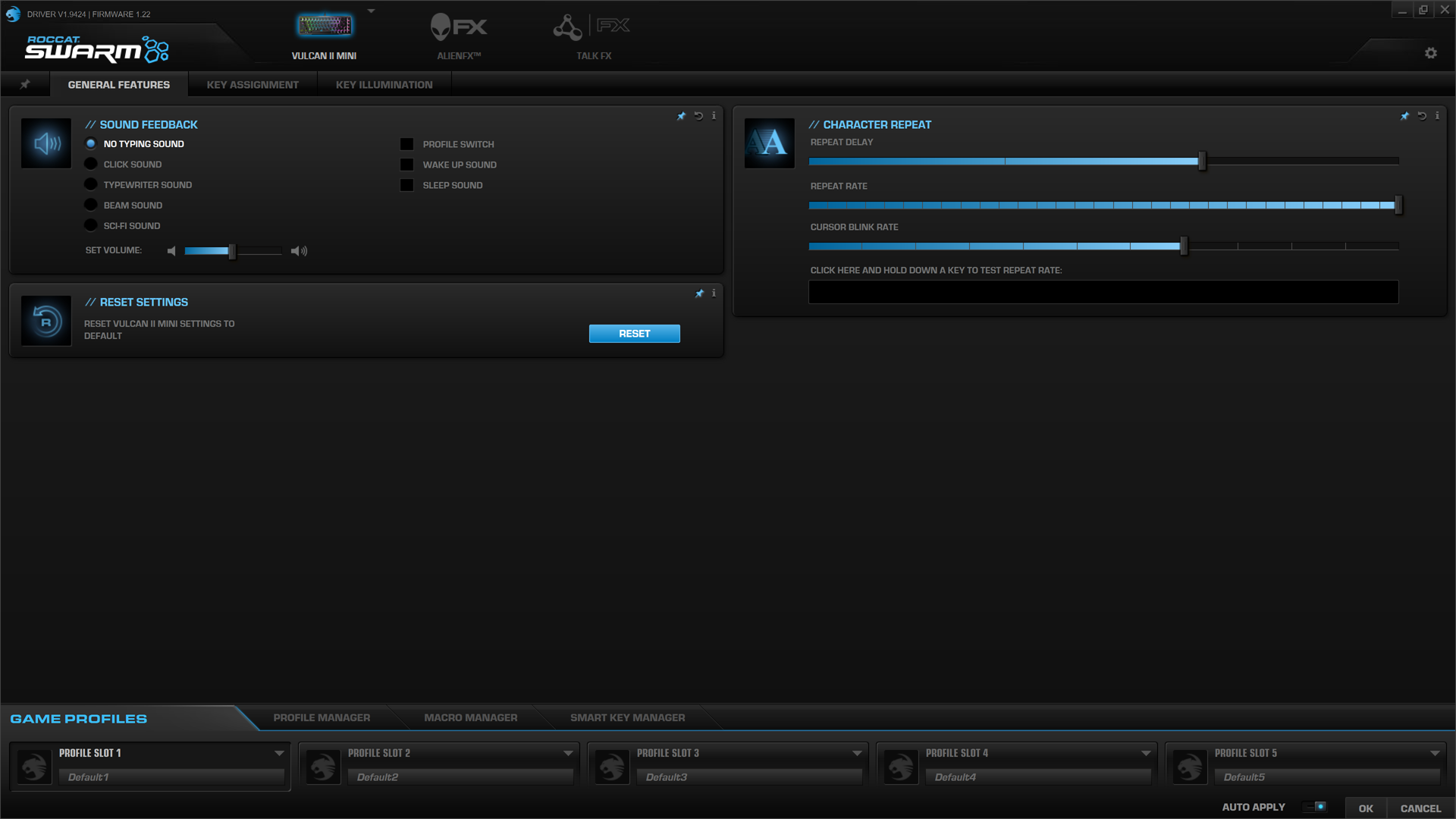

The Vulcan II Mini ships with a number of preset secondary functions (as indicated by the secondary legends) and Roccat’s Aimo RGB lighting profile. But because some of the secondary legends aren’t inherently intuitive, most people will probably want to dig a little deeper and download Roccat’s companion app, Swarm. Swarm is Roccat’s universal peripherals app for remapping keys, setting up onboard profiles, checking for firmware and driver updates, and customizing your device’s RGB lighting.
Like most peripheral apps, Swarm is not the most straightforward or intuitive piece of software you’ll ever use. The Vulcan II Mini does have onboard storage (five profiles), however, so you don’t need to use Swarm for anything past initial configuration. Swarm has some general features you probably won’t use, such as sound feedback — including typing sounds (yes, through your PC) that you can turn on if you...really want to.
But for the most part, you’ll want to turn to Swarm to program (and decipher) the Vulcan II Mini’s many secondary functions. I say “many,” because there are...many — too many. The Vulcan II Mini has three types of secondary keybinds — Fn keys, Game Mode, and Easy-Shift — and yes, they overlap and yet are all still somehow...secondary.
For the keyboard’s default secondary functions (the ones labeled on the keys), you’ll use the Fn key. These keys’ secondary functions can be remapped, though the legends will obviously remain the same. There are 30 Fn keys, all of which have Dual-LED lighting and secondary legends. Only 27 can have their secondary functions remapped (the the three that cannot be changed are the Windows key, which toggle Game Mode; the tab key, which switches onboard profiles; and the right Ctrl key, which turns off the keyboard’s RGB lighting.
Pressing the Fn key plus the Windows key toggles Game Mode. Game Mode is something you’ll find on a lot of gaming keyboards. There’s no universal standard, but Game Mode usually disables keys that, if accidentally pressed, would disrupt your gaming experience. This almost always includes the Windows key, and may also include combinations such as Alt + F4 or Alt + Tab. Roccat’s Game Mode disables the Windows key but is otherwise customizable — you can program almost all of the Vulcan II Mini’s keys in Game Mode, though there are some limitations — non-Fn keys can only be remapped with single keys. Your Game Mode keybindings will be primary while Game Mode is toggled on.
While Game Mode is toggled on, you can access Roccat’s Easy-Shift, which is a second...secondary layer of functionality. You can use Easy-Shift to add a secondary keybind to any non-Fn key, and you can access that secondary keybind using the Easy-Shift key, which is the Caps Lock key by default (you can disable this but you can’t change it, except to swap Easy-Shift for an Easy-Shift toggle). Again, this only works for non-Fn keys — you can still access secondary Fn functionality, you’ll just need to use the Fn key.
Does this sound incredibly confusing? Yes, it’s incredibly confusing and completely unintuitive, all to end up with essentially the same features and programmability competitors offer. SteelSeries’ Apex Pro Mini, for example, lets you remap almost all primary and secondary keybinds (all secondary keybinds are accessed with just one “SS” (Fn) key). The Vulcan II Mini lets you remap almost all primary keybinds — but only in Game Mode, and with limitations on non-Fn keys — and almost all secondary keybinds — but splits it into approximately half with the Fn key, and half with the Easy-Shift key, which is only accessible in Game Mode.
The Bottom Line
Software-based frustrations aside, the Roccat Vulcan II Mini is unexpectedly appealing. It doesn’t look quite as, I don’t know, business-chic as the all-black minimalist bricks we’ve been seeing from other companies, but I kind of like the Vulcan II Mini’s slim, lightweight design, exposed switches, and pretty but admittedly ostentatious RGB lighting. I understand there’s not a lot of room for design creativity in an ultra-compact 60 or 65 percent layout, but you can’t tell me the Apex Pro Mini (and the recently-launched Apex 9 Mini), K70 Pro Wireless, HyperX Alloy Origins 65, and Asus ROG Falchion NX (to name a few) are easily distinguishable.
In addition to being slightly different-looking and very well-lit, the Vulcan II Mini is comfortable for typing, speedy and responsive for gaming, and while its keycaps might be a little too slick, they can always be swapped out. Also, while I found Roccat Swarm to be clunky and convoluted, I can’t say I’m a big fan of any other company’s peripheral software. If you’re looking for an ultra-compact keyboard, the Vulcan II Mini is pretty and a solid performer — for something more unique-looking, you’ll probably need to move onto a custom kit such as the IRISLabs Jris65.

Sarah Jacobsson Purewal is a senior editor at Tom's Hardware covering peripherals, software, and custom builds. You can find more of her work in PCWorld, Macworld, TechHive, CNET, Gizmodo, Tom's Guide, PC Gamer, Men's Health, Men's Fitness, SHAPE, Cosmopolitan, and just about everywhere else.
-
Neilbob Does my desire to have a number pad on a keyboard render me completely past it these days? It certainly feels like it at times.Reply
Not that I'd ever buy a keyboard like this anyway. I don't need a keyboard to resemble a fibre-optic Christmas tree, thank you very much :)
(Especially for prices such as those being hurled around here).
